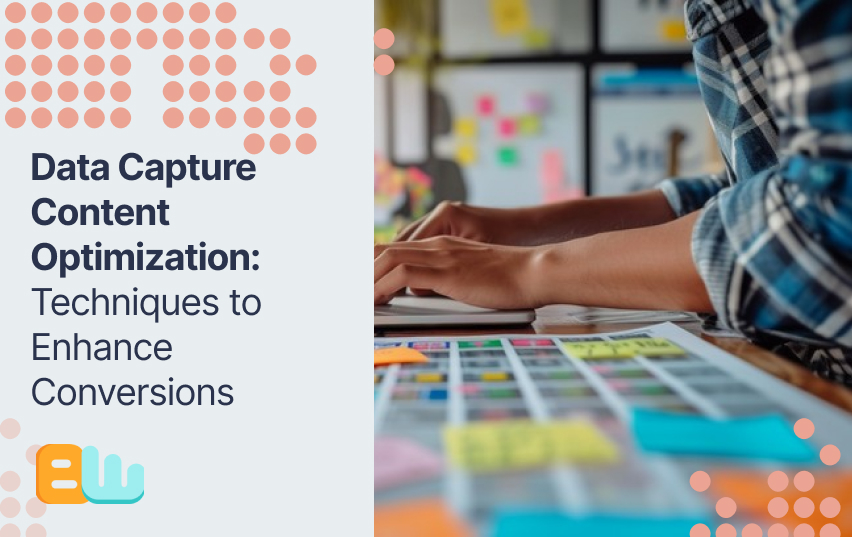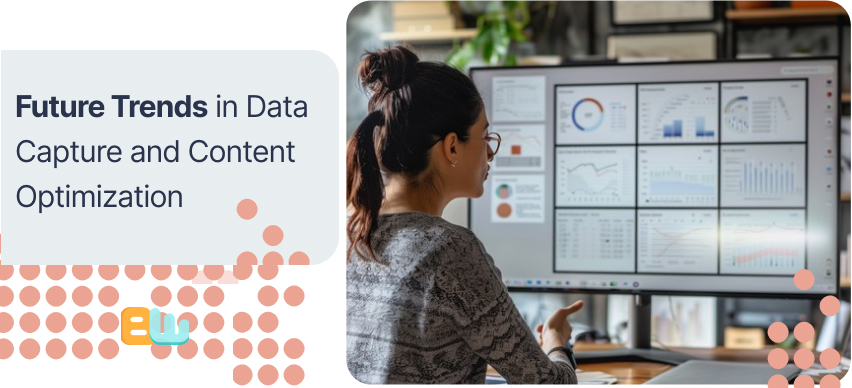
Do you consistently attract visitors to your website only to discover that most are not engaging in the desired actions you had hoped for? Frustrating, isn’t it? This is where content optimization comes into play to turn your visitors into desired conversions. Content optimization is a powerful way to drive real results by employing strategic techniques. It involves optimizing your website content to increase customer engagement, leads, and sales.
This guide will reveal key techniques and strategies for data capture content optimization. We will discuss the importance of data capture in conversion optimization and how it enhances content personalization and engagement. We will also explore techniques for effective data capture, such as implementing user behavior-tracking tools and utilizing forms and surveys for direct feedback. Additionally, we will delve into optimizing content for maximum data collection, including designing content with data capture in mind and integrating data capture elements seamlessly.
Understanding the Importance of Data Capture in Conversion Optimization

Understanding the importance of data capture in conversion optimization is essential for maximizing the effectiveness of your content and driving desired actions from your website visitors. Conversion rate, user experience, desired action, and content optimization are all key terms that play a crucial role in this process.
Conversion rate is the percentage of website visitors who take actions such as making a purchase, subscribing to a newsletter, filling out forms, or clicking on call-to-action buttons. It measures how effectively your website can convert visitors into customers or leads. A high conversion rate is a significant success factor for any website, as it increases revenue, improves return on investment (ROI), and maximizes the value of each visitor.
The Role of Data in Crafting User-Centric Content
Data is crucial in crafting user-centric content that resonates with your target audience and drives conversions. By collecting and analyzing data about your website visitors, you can gain valuable insights into their demographics, preferences, and behavior. This information allows you to understand their needs and pain points, enabling you to create content that
Data is critical in crafting user-centric content by providing insights into user demographics, behavior, and preferences. By leveraging this data, you can optimize your content to meet the specific needs of your target audience and drive desired actions from your website visitors.
How Data Capture Enhances Content Personalization and Engagement
Data capture enhances content personalization and engagement, leading to better conversion rates. By collecting and analyzing data about your website visitors, you can gain valuable insights into their preferences, interests, and behavior. This information allows you to create personalized content experiences that resonate with your audience and increase engagement.
Data capture enhances content personalization and engagement by enabling targeted messaging, tracking user interactions, and integrating social media into your content strategy. By leveraging data, you can create personalized and engaging content experiences that drive higher conversion rates and foster a deeper connection with your audience.
Key Techniques for Effective Data Capture

Effective data capture is essential for optimizing your content and driving conversions. Several key techniques can enhance data capture and improve the quality and quantity of data collected. One technique is implementing user behavior tracking tools like Google Analytics or heat maps. These tools provide insights into how users interact with your website, what pages they visit, and their journey through the site. You can identify pain points, optimize user flow, and improve conversion rates by tracking user behavior.
Another technique is to utilize forms and surveys for direct feedback from your audience. Adding forms or surveys to your website allows you to collect valuable information about visitors’ preferences, needs, and pain points. This direct feedback can tailor your content and create a more personalized and engaging experience for your audience.
Implementing User Behavior Tracking Tools
Implementing user behavior tracking tools is an effective technique for capturing data and optimizing your content for conversions. These tools, such as Google Analytics or heat maps, provide valuable insights into how users interact with your website, what pages they visit, and their journey through the site. By tracking user behavior, you can identify pain points and areas for improvement in your website design and content. For example, if you notice a high bounce rate on a particular page, you can investigate why users leave and make adjustments to improve engagement and retention.
Utilizing Forms and Surveys for Direct Feedback
Utilizing forms and surveys for direct feedback is an effective technique for capturing data and optimizing your content for conversions. Adding forms or surveys to your website allows you to collect valuable information about visitors’ preferences, needs, and pain points. Forms can capture contact information, such as email addresses or phone numbers, which can be used for targeted marketing campaigns or lead generation.
By collecting direct feedback from your audience, you can gain valuable insights into their needs and tailor your content to address them. This personalized approach increases the relevance and effectiveness of your messaging, leading to higher engagement and conversion rates.
Optimizing Content for Maximum Data Collection

Optimizing your content for maximum data collection is crucial for capturing valuable insights about your audience and optimizing your content strategy. Key techniques can enhance data capture and optimize content for conversions.
One technique is to design content with data capture in mind by incorporating relevant forms or surveys. By strategically placing forms or surveys within your content, you can collect valuable information about your audience’s preferences, needs, and pain points. Another technique is to integrate data capture elements seamlessly into your content.
Designing Content with Data Capture in Mind
Designing content with data capture in mind is a key technique for optimizing your content and driving conversions. By incorporating relevant forms or surveys into your content, you can collect valuable information about your audience and tailor it to their needs and interests. When designing content with data capture in mind, it is important to consider the user’s search intent. By understanding why users search for your content, you can create tailored content that addresses their needs and provides valuable solutions. Internal linking is another important aspect when designing content with data capture in mind.
Best Practices for Integrating Data Capture Elements Seamlessly
Integrating data capture elements seamlessly into your content is crucial for capturing valuable insights and optimizing your content strategy. There are several best practices to consider when incorporating data capture elements into your content.
One best practice is to ensure data capture elements are strategically placed throughout your content. Consider the user’s journey and strategically embed forms or surveys at key points where users will likely provide feedback or take action. Another best practice is to use clear and compelling calls-to-action (CTAs) to encourage users to engage with your data capture elements. Communicate the value proposition and incentivize users to provide information or participate in surveys.
Leveraging Captured Data to Optimize Content Strategy

Leveraging captured data is essential for optimizing your content strategy and driving conversions. By analyzing the data collected from your website visitors, you can gain valuable insights into their needs, preferences, and behavior. This data can then be used to optimize your content strategy in several ways.
Leveraging captured data allows you to optimize your content strategy by understanding user needs, tailoring content to user segments, and optimizing content distribution channels. This data-driven approach increases the relevance and effectiveness of your content, leading to higher engagement and conversion rates.
Analyzing Data to Understand User Needs and Preferences
Analyzing data is crucial in understanding user needs and preferences and optimizing your content strategy. By analyzing the data collected from your website visitors, you can gain valuable insights into their demographics, behavior, and preferences.
Analyzing data is essential for understanding user needs and preferences and optimizing your content strategy. By leveraging the insights gained from data analysis, you can create more targeted and engaging content that drives higher engagement and conversion rates.
Tailoring Content to User Segments for Increased Relevance
Tailoring content to user segments is a key strategy for increasing relevance and optimizing your content for conversions. By segmenting your audience based on their characteristics, preferences, and behavior, you can create personalized content experiences that resonate with specific user segments.
Tailoring content to user segments allows you to create more relevant and engaging content experiences that drive conversions. By leveraging user data and segmenting your audience, you can optimize your content strategy and deliver personalized content that resonates with specific user segments.
Future Trends in Data Capture and Content Optimization

The evolution of data capture technologies is a significant trend in the field. With advancements in marketing automation and artificial intelligence, data capture technologies are becoming more sophisticated and efficient. These technologies enable businesses to collect and analyze data in real time, providing valuable insights that can be used to optimize content and drive conversions.
Future data capture and content optimization trends focus on leveraging technological advancements to create highly personalized and optimized content experiences. By staying informed about these trends and incorporating them into your content strategy, you can drive higher engagement and conversion rates and stay ahead of the competition.
The Evolution of Data Capture Technologies
The evolution of data capture technologies is revolutionizing the way businesses collect and analyze data. Marketing automation, artificial intelligence, and machine learning advancements have made data capture technologies more efficient and sophisticated. Marketing automation platforms allow businesses to automate data capture processes, enabling them to collect and analyze data in real time. These platforms can track user behavior, segment audiences, and deliver personalized content experiences based on data-driven insights.
Overall, the evolution of data capture technologies enables businesses to collect and analyze data more efficiently and effectively. By leveraging these technologies, businesses can optimize their content strategy, drive higher engagement and conversion rates, and gain a competitive edge in the market.
Emerging Practices in Content Personalization and Optimization
One emerging practice is using conversion rate optimization (CRO) tools. These tools enable businesses to test and optimize real-time content based on data-driven insights. Businesses can continuously refine and optimize content to improve engagement and conversion rates.
Another emerging practice is the integration of content personalization with search engine optimization. Businesses can improve their search engine rankings and increase organic traffic by optimizing content with relevant keywords and user intent. This integration ensures businesses deliver relevant and engaging content to their audience, driving higher conversion rates.
Conclusion
Data capture plays a pivotal role in enhancing user experiences and driving conversions. Businesses can personalize content, engage audiences effectively, and optimize their overall content strategy by leveraging data-driven strategies. Implementing user behavior tracking tools, utilizing forms for feedback, and designing content with data in mind are vital techniques to maximize data collection. Analyzing captured data helps understand user needs, tailor content for relevance, and overcome challenges such as privacy concerns. Embracing future trends in data capture technologies will further revolutionize content personalization and optimization. Stay ahead by integrating data capture seamlessly into your content strategy for sustained growth and improved user engagement.
